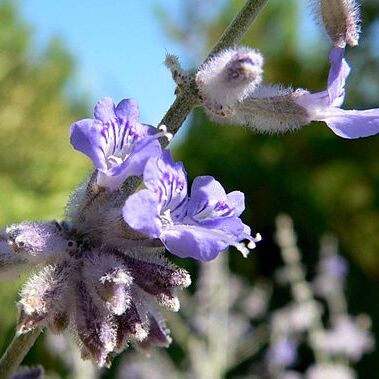Stems ca. 50 cm, branched from base, densely stellate, yellow glandular. Petiole 4-6 mm; leaf blade linear-lanceolate, 4-5(-6) cm × 4-9 mm, base cuneate, 1-pinnatipartite; lobes oblong to ovate, 2-4 × 1-1.5 mm, sparsely stellate, densely yellow glandular, apex obtuse. Verticillasters in lax racemes or panicles 10-15 cm; floral leaves linear, 0.8-1.7 cm × 0.8-3 mm; bracts violet, ovate to elliptic, ca. 0.7 × 0.4 mm, deciduous, membranous, margin white ciliate. Pedicel 1-1.5 mm, densely pubescent, spreading to pendulous. Calyx 5-6 × 1.5-2.5 mm, purple, base densely white or purple hirsute, yellowish glandular, margin ciliate, apex sparsely pubescent to subglabrous, tube 4-5 × 1.5-2 mm; upper lip ca. 1 × 2 mm, obscurely 3-denticulate; lower lip nearly as long as upper lip. Corolla blue, ca. 1 cm, glabrous, sparsely glandular, tube 5-6 × 2 mm; upper lip 3-3.5 × 4-4.5 mm, dark purple lineate; lobes elliptic to ovate, middle lobes ca. 1.5 × 1 mm, lateral lobes ca. 1 × 1.5 mm; lower lip oblong-elliptic, ca. 3 × 1 mm, margin entire, apex obtuse. Nutlets ca. 2 × 1 mm, obtuse. Fl. Jun-Jul, fr. Jul-Aug.
More
A herb. It grows to 120 cm high. It spreads 45-90 cm wide. The leaves are oval or oblong. They are 5-6 cm long. They are silvery green. The leaves are scalloped along the edge or have coarse teeth. The flowers are soft blue. They grow in narrow spikes. These are 30 cm long.

